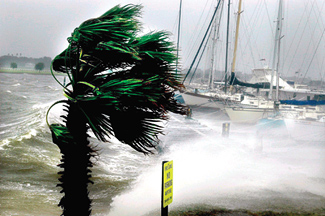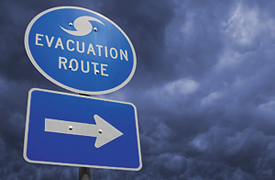Broadcasting in Hurricane Country
SEATTLE
According to climatologists, hurricanes have been battering this country's southern east and Gulf Coast since the beginning of time. And since there's no reason to think they aren't going to continue to happen, television stations in that region have got to be prepared to live with them.
A lot has changed for the duopoly operation of WGNO (ABC) and WNOL-TV (CW) since Hurricane Katrina struck their New Orleans market in late August 2005. This is not surprising, as both of their studios and transmissions facilities were des-troyed in the storm.

"Since Katrina we've had to rebuild transmission facilities and studio facilities," said Steve Zanolini, director of engineering for the two stations. "For transmission facilities, we've partnered with Hearst station WDSU, and we ended up building a joint transmission facility that's 20 feet above the ground. We did a lot of structural improvements to the tower to make sure it would hold up to at least a Category 3, 4, 5 [hurricane]."
Since their landlord evicted them from their pre-Katrina studio space, the stations have had to shop around, and ended up moving from downtown New Orleans to Metairie, a few miles to the northeast.
"We're actually above sea level at ground level, which is nice," said Zanolini, "And we sit on the eighth floor of the facility in fairly hardened space. So in other words, we would choose to stay here through a strong Category Three, and could move into the interior space of our facility and maintain operations."
READY IF A BIG ONE COMES
The studio location is right alongside Interstate 10, which is the evacuation route to Baton Rouge, La., where the stations have already made plans to operate during the next big one.
"If the local authorities tell us we have to evacuate, that's when we pick up and go to the safe harbor, which would, at this point, be one of the affiliate stations in Baton Rouge," said Zanolini.
Robert Gass, director of technology at WWL-TV in New Orleans, added that his station learned the importance of making allowances for medical care.
"We have made arrangements so that during a disaster we have access to doctors, and can fill prescriptions for station staff who need medication," Gass said.
Frank Peterman, director of technology at Houston's KHOU, admits he had an advantage over his counterparts affected by Hurricane Katrina when Hurricane Ike came ashore in 2008.
"We learned a lot by what happened in New Orleans, because we were a primary provider of equipment and those types of things when they lost the stations, went off the air," Peterman said. "So we learned a lot, and as a matter of fact we even used some of the information in the hurricane plan that they had developed."

One New Orleans broadcaster has moved its studios along side an evacuation route. Their disaster plan was several years in the making and implementation.
"Thank goodness we finalized it at the beginning of last year," he said.
RAISE IT UP TO HIGHER GROUND
After seeing the New Orleans flooding, Peterman said the station moved its central equipment room from the ground floor to the second floor.
"Our studios remain on the ground floor, but we ran cabling and adapted a second-floor conference room so that it can act as an emergency studio if the first floor got flooded."
Though the Savannah, Ga., market has not actually been targeted by a hurricane in recent years, that region was evacuated for Hurricane Floyd in 1999, and was almost hit by Hurricane Hugo ten years earlier. So hurricane planning has been a constant there.
"We've got a generator right here at the studios that can run the whole building," said WSAV-TV engineer Joe Shearouse. The station's new digital transmitter draws more power than the station's backup transmission generator can provide, but since a hurricane gives a couple of days warning, Shearouse says that station's group owner would probably rent one and deliver it in time to keep things operational.
SURVIVAL KIT content CHECK
The station has also stockpiled what they need to survive in the days after a hurricane strikes.
"We've got supplies here, food and water, batteries, gas cans, chain saws, and the company has a disaster plan where they would bring in outside help should we need it," said Shearouse. "They also have a plan for getting fuel to the station where that might be needed."
Even though a station's transmitter has been taken out, power to the viewers interrupted, and the viewers themselves evacuated from a Hurricane-struck television market, there's reason for these stations to continue to operate, said WGNO/WNOL-TV's Zanolini.
"Since Katrina, we've carved out deals with either sister stations in surrounding markets, or cable stations in surrounding markets that have the highest concentration of evacuees, he said."
The stations have found that hurricane refugees have a tremendous hunger for news from their homes.
Zanolini recalled that even though his station's transmitter site was in shambles, it was still possible to maintain connectivity with at least some of its viewing audience by using a Baton Rouge satellite uplink to get programming to cable headends.
"A good majority of the cable systems were on board to downlinking that signal," said Zanolini. "In fact even DirecTV and Dish were back on the air with us by late that afternoon." Just like the Boy Scouts, stations in hurricane country have to be prepared.
ENG in a Hurricane
Television stations and broadcast groups may develop strategic plans and marshal their armies should a hurricane come to their market, but there's also the ENG shooter, mano a mano against the hurricane. TV Technology asked Richard Campbell for advice about ENG in a hurricane. Campbell has shot video in 25 named hurricanes and just spent five weeks during the past May and June on assignment for The Weather Channel with a tornado researching crew.
In spite of the macho nature of his job, he advises that safety for crew and equipment comes first.
"It does you no good trying to get great pictures in a storm if you get hurt or get your gear damaged," Campbell said. "If you get killed, you become the story instead of getting the story." With modern weather satellites and other prediction technology, a storm doesn't just suddenly appear out of nowhere. Campbell puts the time before the storm to good use.
"I put about 40 minutes before the storm really hits to prepare. I'll tape up the seams on the camera, and make sure I have a good storm cover on it, with zipper closures instead of Velcro which can fail and result in loss of the rain cover in the teeth of the storm.
"And extra garbage bags to protect any of the peripheral gear," he said. "And make sure you are protected. A really good, high-quality rain suit and boots are really important."
For live shots during a hurricane, Campbell's camera is generally hardwired to the ENG or SNG van. But on those occasions he has to use microwave to link to his truck, the same message about weatherproofing applies.
"I use a rain cover with extra room in the back for the microwave transmitter, so it stays absolutely dry like the camera."
The viewer often sees the reporter barely able to stand his ground in the driving wind and rain, while the camera remains amazingly stable. Campbell said there's a little trick at work there.
"If you're on a tripod, you want to find a protected spot, a parking garage, a building that offers protection in sort of an 'L' shape. If you find the right spot for live shots, you can really protect the camera well."
When Campbell is shooting with the camera on his shoulder, steadiness doesn't matter as much. But he puts into practice a lesson he learned from Dan Rather's book "The Camera Never Blinks." This involves having the reporter guard his blind right side where the camera blocks an ENG shooter's view.
"I know other shooters who have been hit by substantial pieces of debris they didn't see coming from their blind side."
For anyone who wants to get the experience of shooting ENG in a hurricane, but from the safety of their own home, Campbell offers an additional suggestion.
"If you want to know what it's like, stand in your yard and have somebody spray you in the face for three or four hours with a water hose. And then wear the same clothes for two or three days; don't shower, don't shave."
Volunteers?
-- Craig Johnston
The professional video industry's #1 source for news, trends and product and tech information. Sign up below.
